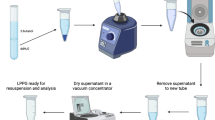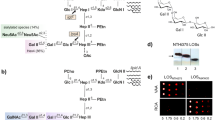Abstract
Helicobacter pylori expresses separate binding characteristics depending on growth conditions, as documented by binding to human erythrocyte glycoconjugates. Cells grown in Ham's F12 liquid medium exhibited a selective sialic acid-dependent binding to polyglycosylceramides, PGCs (Miller-Podraza et al. (1996) Glycoconjugate J 13:453–60). There was no binding to traditional sialylated glycoconjugates like shorter-chain gangliosides, glycophorin or fetuin. However, cells grown on Brucella agar bound both to PGCs and other sialylated glycoconjugates. Fetuin was an effective inhibitor of haemagglutination caused by agar-grown cells, but had no or a very weak inhibitory effect on haemagglutination by F12-grown bacteria. PGCs were strong inhibitors in both cases, while asialofetuin was completely ineffective. The results indicate that H. pylori is able to express two separate sialic acid-dependent specificities, one represented by binding to fetuin, as described before, and another represented by a selective binding to PGCs. Abbreviations: PGCs, polyglycosylceramides; TLC, thin-layer chromatography; SDS PAGE, sodium dodecylsulfate polyacrylamide gel electrophoresis; BSA, bovine serum albumin; C, chloroform; M, methanol. The carbohydrate and glycosphingolipid nomenclatures are according to recommendations of IUPAC-IUB Commission on Biochemical Nomenclature (Lipids (1977) 12:455–68; J Biol Chem (1982) 257:3347–51 and J Biol Chem (1987) 262:13–18).
Similar content being viewed by others
References
Dooley CP (1993) Curr Opin Gastroenterol 9: 112-17.
DeCross AJ, Marshall BJ (1993) Am J Med Sci 306: 381-92.
Wadström T (1995) Curr Opin Gastroenterol 11: 69-75.
Slomiany BL, Piotrowski A, Samanta A, VanHorn K, Murty VLN, Slomiany A (1989) Biochem Int 19: 929-36.
Saitoh T, Natomi H, Zhao W, Okuzumi K, Sugano K, Iwamori M, Nagai Y (1991) FEBS ¸ett 282: 385-87.
Lingwood CA, Huesca M, Kuksis A (1992) Infect Immun 60: 2470-74.
Borén T, Falk P, Roth KA, Larson G, Normark S (1993) Science 262: 1892-95.
Evans DG, Evans DJ Jr (1995) Methods Enzymol 253: 336-60.
Kamisago S, Iwamori M, Tai T, Mitamura K, Yazaki Y, Sugano K (1996) Infect Immun 64: 624-28.
Robinson J, Goodwin CS, Cooper M, Burke V, Mee BJ (1990) J Med Microbiol 33: 277-84.
Armstrong JA, Cooper M, Goodwin CS, Robinson J, Wee SH, Burton M, Burke V (1991) J Med Microbiol 34: 181-87.
Huang J, Keeling PWN, Smyth CJ (1992) J Gen Microbiol 138: 1503-13.
Lelwala-Guruge J, Ljungh As, Wadström T (1992) APMIS 100: 908-13.
Evans DG, Evans DJ Jr, Moulds JJ, Graham DY (1988) Infect Immun 56: 2896-906.
Evans DG, Karjalainen TK, Evans DJ Jr, Graham DY, Lee C-H (1993) J Bacteriol 175: 674-83.
O'Toole PW, Janzon, L, Doig P. Huang J, Kostrzynska M, Trust TJ (1995) J Bacteriol 177: 6049-57.
Miller-Podraza H, Abul Milh M, Bergström J, Karlsson K-A (1996) Glycoconjugate J 13: 453-60.
Miller-Podraza H, Andersson C, Karlsson, K-A (1993) Biochim Biophys Acta 1168: 330-39.
Karlsson K-A (1987) Methods Enzymol 138: 212-20.
Folch J, Lees M, Stanley GHS (1957) J Biol Chem 226: 497-509.
Wells MA, Dittmer JC (1963) Biochemistry 2: 1259-63.
Pan YT, Elbein AD (1990) Prog Drug Res 34: 163-207.
Thomas DB, Winzler, RJ (1969) J Biol Chem 244: 5943-46.
Yoshima H, Furthmayr H, Kobata A (1980) J Biol Chem 255: 9713-18.
Zdebska E, Krauze R. Koscielak J (1983) Carbohydrate Res 120: 113-30.
Wiegandt H (1974) Eur J Biochem 453: 367-69.
Nilsson B, Nordén NE, Svensson S (1979) J Biol Chem 254: 4545-53.
Spiro RG (1960) J Biol Chem 235: 2860-69.
Huesca M, Borgia S, Hoffman P, Lingwood CA (1996) Infect Immun 64: 2643-48.
Author information
Authors and Affiliations
Rights and permissions
About this article
Cite this article
Miller-Podraza, H., Bergstrom, J., Abul Milh, M. et al. Recognition of glycoconjugates by Helicobacter pylori. Comparison of two sialic acid-dependent specificities based on haemagglutination and binding to human erythrocyte glycoconjugates. Glycoconj J 14, 467–471 (1997). https://doi.org/10.1023/A:1018599401772
Issue Date:
DOI: https://doi.org/10.1023/A:1018599401772




